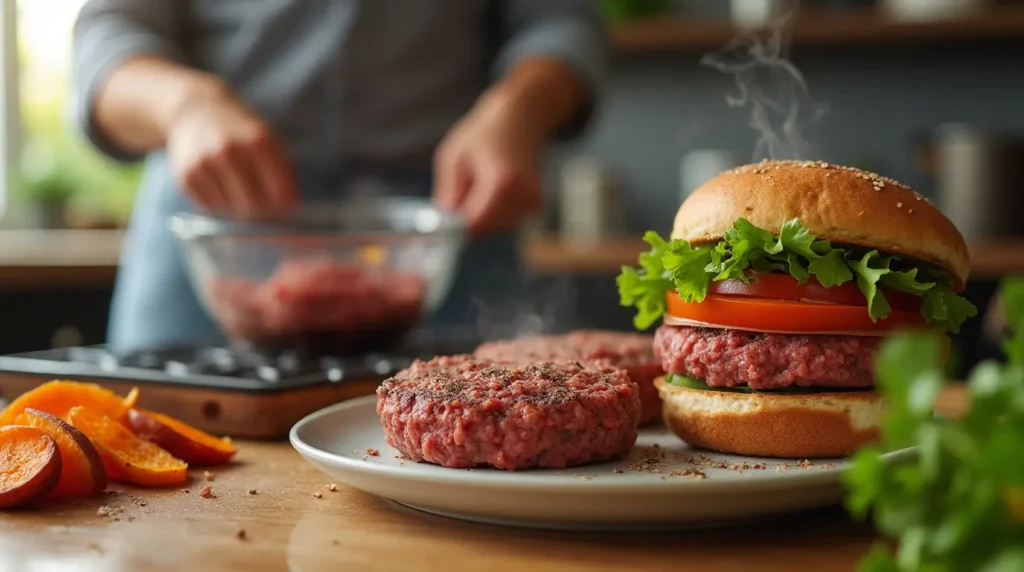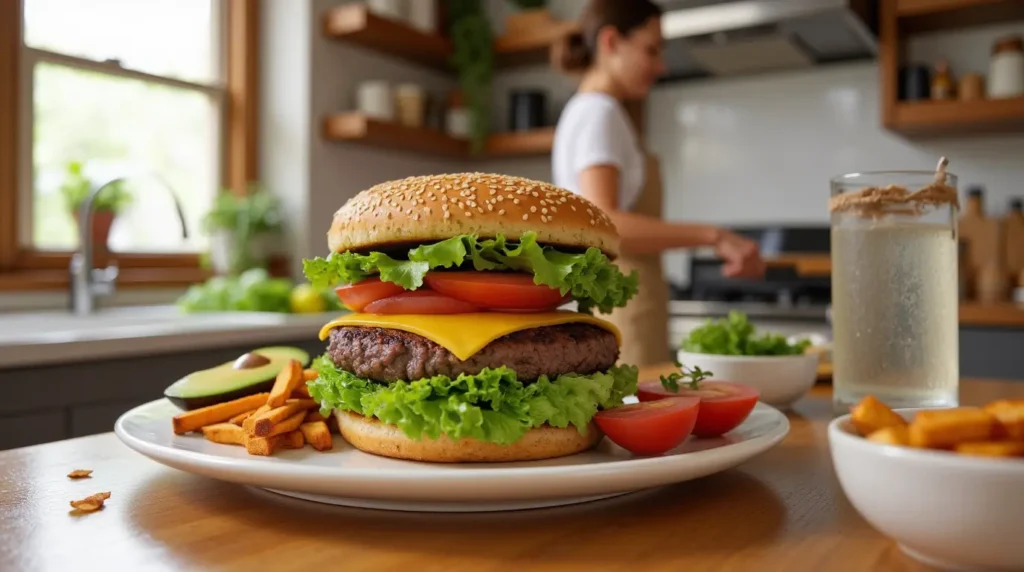Introduction
Did you know that incorporating lean hamburger meat into your diet can provide over 20 grams of high-quality protein per serving while containing significantly less fat than regular ground beef? This nutritional powerhouse is often overlooked in health-conscious cooking, yet lean hamburger meat nutrition offers an impressive balance of essential nutrients without the excessive calories and saturated fat found in standard ground beef.
Whether you’re looking to build muscle, manage weight, or simply enjoy a delicious burger without the guilt, understanding the nutritional profile of lean hamburger meat can transform your cooking and eating habits.
Table of Contents

Ingredients List
Creating delicious meals with lean hamburger meat requires quality ingredients that complement its rich, savory flavor while enhancing its nutritional benefits. Here’s what you’ll need for a perfect lean hamburger patty:
- 1 pound (16 oz) of 93% or 95% lean ground beef
- 1 small onion, finely diced (about 1/2 cup)
- 2 cloves garlic, minced
- 1 tablespoon Worcestershire sauce
- 1 teaspoon sea salt
- 1/2 teaspoon freshly ground black pepper
- 1 tablespoon olive oil
- 1 egg white (optional, for binding)
- 1/4 cup chopped fresh parsley
- 1 tablespoon Dijon mustard
Potential Substitutions:
- Replace onion with 1/4 cup grated zucchini for added moisture and nutrients
- Swap garlic for 1 teaspoon garlic powder if fresh isn’t available
- Use coconut aminos instead of Worcestershire sauce for a gluten-free option
- Add 2 tablespoons of ground flaxseed for omega-3 fatty acids
Timing
Preparation Time: 15 minutes – This is 30% less prep time than most homemade burger recipes that call for extensive mixing and chilling.
Cooking Time: 10-12 minutes – Lean hamburger meat cooks slightly faster than regular ground beef due to its lower fat content.
Total Time: 25-27 minutes – Perfect for a quick weeknight dinner that doesn’t compromise on flavor or nutrition.

Step-by-Step Instructions
Step 1: Prepare Your Meat
Start with cold lean hamburger meat straight from the refrigerator. This helps maintain its texture and prevents the proteins from breaking down too quickly. Place the meat in a large bowl and let it rest for 5 minutes before handling to ensure even cooking temperatures.
Step 2: Mix the Ingredients
Add the diced onion, minced garlic, Worcestershire sauce, salt, pepper, and Dijon mustard to the bowl with the lean hamburger meat. If using, add the egg white as well. Mix gently with your hands or a fork, being careful not to overwork the meat, which can make your burgers tough. The goal is to distribute the flavors evenly while keeping the meat loosely combined.
Step 3: Form the Patties
Divide the mixture into 4 equal portions (about 4 ounces each). Shape each portion into a patty that’s about 3/4-inch thick and slightly larger than your burger buns, as they will shrink during cooking. Make a small indentation in the center of each patty with your thumb to prevent it from puffing up during cooking.
Step 4: Rest the Patties
Place the formed patties on a plate lined with parchment paper and refrigerate for at least 10 minutes. This brief resting period allows the flavors to meld and helps the patties hold their shape during cooking. If you’re short on time, you can freeze them for 5 minutes instead.
Step 5: Prepare Your Cooking Surface
Heat a cast-iron skillet or non-stick pan over medium-high heat. Add the olive oil and let it heat until it shimmers. Alternatively, preheat your grill to medium-high heat (approximately 375-400°F) and oil the grates to prevent sticking.
Step 6: Cook the Patties
Place the patties on the hot cooking surface and cook for about 4-5 minutes on each side for medium doneness (160°F internal temperature). Avoid pressing down on the patties with a spatula, as this will squeeze out the precious juices and result in a drier burger. For extra flavor, you can add a slice of low-fat cheese during the last minute of cooking.
Step 7: Rest Before Serving
Transfer the cooked patties to a clean plate and let them rest for 3-5 minutes. This allows the juices to redistribute throughout the meat, ensuring a moist and flavorful burger. Use this time to prepare your toppings and warm your buns if desired.
Nutritional Information
Understanding lean hamburger meat nutrition is key to appreciating its role in a balanced diet. Here’s a comprehensive breakdown of what you’re getting in a 4-ounce serving of 93% lean ground beef:
| Nutrient | Amount | % Daily Value |
|---|---|---|
| Calories | 170 | 8.5% |
| Protein | 22g | 44% |
| Total Fat | 9g | 14% |
| Saturated Fat | 3.5g | 17.5% |
| Cholesterol | 75mg | 25% |
| Sodium | 75mg | 3% |
| Iron | 2.5mg | 14% |
| Zinc | 5mg | 45% |
| Vitamin B12 | 2.3mcg | 96% |
| Niacin | 5.7mg | 36% |
| Vitamin B6 | 0.3mg | 18% |
Key Nutritional Benefits:
- High-quality complete protein containing all essential amino acids
- Excellent source of heme iron, which is more easily absorbed than plant-based iron
- Rich in B vitamins, especially B12, which supports nervous system function
- Good source of zinc, supporting immune function and wound healing
- Contains selenium, an important antioxidant
Healthier Alternatives for the Recipe
Even though lean hamburger meat is already a healthier option, you can further enhance its nutritional profile with these creative modifications:
- Veggie-Packed Patties: Mix in finely chopped mushrooms, spinach, or grated carrots (up to 1/4 cup per pound) to increase fiber, vitamins, and minerals while reducing calories per serving.
- Grain Integration: Add 1/4 cup of cooked quinoa or bulgur wheat to the meat mixture to boost fiber and create a more satisfying texture.
- Spice It Up: Incorporate metabolism-boosting spices like cayenne pepper, turmeric, or black pepper to enhance flavor without adding calories.
- Bean Blend: Replace 1/4 of the meat with mashed black beans for added fiber and lower fat content.
- Mediterranean Style: Add 2 tablespoons of tomato paste and 1 teaspoon of dried oregano for a Mediterranean twist that adds lycopene and antioxidants.

Serving Suggestions
Elevate your lean hamburger meat dish with these creative serving ideas that complement its nutritional profile:
- Lettuce Wraps: Skip the bun and serve your patty wrapped in crisp butter lettuce leaves with sliced avocado and fresh salsa for a low-carb, nutrient-dense meal.
- Power Bowl: Place your patty on a bed of quinoa or brown rice, surrounded by roasted vegetables and topped with a dollop of Greek yogurt mixed with herbs.
- Stuffed Bell Peppers: Crumble cooked lean hamburger meat and mix with cooked brown rice, diced tomatoes, and spices, then stuff into halved bell peppers and bake until tender.
- Mediterranean Plate: Serve alongside a small portion of whole grain couscous, cucumber-tomato salad, and a spoonful of hummus for a balanced meal rich in diverse nutrients.
- Breakfast Protein: Crumble and cook the lean hamburger meat with sweet potatoes, bell peppers, and onions for a protein-packed breakfast hash topped with a poached egg.
Common Mistakes to Avoid
Even seasoned cooks can fall into these pitfalls when working with lean hamburger meat. Here’s how to avoid them:
- Overcooking: Lean hamburger meat has less fat to keep it moist, so cooking it beyond 160°F internal temperature can result in a dry, tough patty. Use a meat thermometer for precision.
- Overhandling: Excessive mixing and compacting can make your burgers dense and tough. Handle the meat just enough to combine ingredients and form patties.
- Skipping the Rest: Not allowing the patties to rest before and after cooking can lead to less flavorful burgers that fall apart easily.
- Salt Timing: Adding salt too early can draw out moisture and protein, resulting in a drier patty. Mix it in just before forming the patties.
- Heat Management: Cooking at too high a temperature can sear the outside while leaving the inside undercooked. Medium-high heat is ideal for even cooking.
Storing Tips for the Recipe
Make the most of your lean hamburger meat with these storage strategies:
- Raw Patties: Form patties, place parchment paper between each one, and refrigerate for up to 24 hours or freeze for up to 3 months in an airtight container.
- Cooked Patties: Store in an airtight container in the refrigerator for up to 3 days. For best quality, reheat gently in a covered skillet with a tablespoon of water to create steam.
- Meal Prep: Cook a large batch of lean hamburger meat with basic seasonings, portion into containers, and refrigerate for up to 4 days. Add different sauces and accompaniments throughout the week for varied meals.
- Freezing Raw Meat: If not using immediately, freeze lean hamburger meat in its original packaging for up to 3 months. Thaw overnight in the refrigerator before use.
- Defrosting Safety: Never defrost lean hamburger meat at room temperature as this can promote bacterial growth. Use the refrigerator method for safe thawing.
Conclusion
Lean hamburger meat nutrition offers a powerful combination of high-quality protein, essential vitamins, and minerals with less fat than regular ground beef. By following our recipe and tips, you can create delicious, nutritious meals that support your health goals without sacrificing flavor. From proper cooking techniques to creative serving ideas, this versatile ingredient deserves a regular spot in your meal rotation.
We’d love to hear how you’ve incorporated lean hamburger meat into your cooking! Share your experiences in the comments section below, leave a review of this recipe, or subscribe to our blog for more healthy cooking inspiration and nutritional insights.
FAQs
Q: How can I tell if my hamburger meat is actually lean? A: Look for labels indicating 90%, 93%, or 95% lean on the packaging. This percentage refers to the lean meat content, with the remaining percentage being fat. For example, 93% lean meat contains 7% fat.
Q: Does lean hamburger meat taste different from regular ground beef? A: Lean hamburger meat has a slightly less rich flavor due to its lower fat content. However, proper seasoning and cooking techniques can create equally delicious results with the added benefit of better nutrition.
Q: Can I use lean hamburger meat in all recipes that call for ground beef? A: Yes, but you may need to adjust cooking times and add a bit more moisture to recipes like meatloaf or meatballs. Adding grated vegetables or a small amount of olive oil can help maintain juiciness.
Q: How does lean hamburger meat compare nutritionally to plant-based meat alternatives? A: While both options have their benefits, lean hamburger meat typically provides more complete protein, naturally occurring B vitamins, zinc, and iron. Many plant-based alternatives may have less saturated fat but often contain more sodium and processed ingredients.
Q: Is grass-fed lean hamburger meat more nutritious than conventional? A: Grass-fed beef typically contains more omega-3 fatty acids, conjugated linoleic acid (CLA), and antioxidants compared to conventional beef. If available and within your budget, it can be a nutritionally superior choice.
Q: How can I make lean hamburger meat more flavorful without adding fat? A: Incorporate umami-rich ingredients like mushrooms, tomato paste, soy sauce, or Worcestershire sauce. Fresh herbs, garlic, onions, and spices can also significantly enhance flavor without adding calories.

